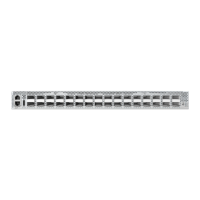C
HAPTER
15
| IP Configuration
Setting the Switch’s IP Address (IP Version 6)
– 579 –
SHOWING IPV6
ADDRESSES
Use the IP > IPv6 Configuration (Show IPv6 Address) page to display the
IPv6 addresses assigned to an interface.
CLI REFERENCES
◆ "show ipv6 interface" on page 1414
PARAMETERS
These parameters are displayed:
◆ VLAN – ID of a configured VLAN which is to be used for management
access. By default, all ports on the switch are members of VLAN 1.
However, the management station can be attached to a port belonging
to any VLAN, as long as that VLAN has been assigned an IP address.
(Range: 1-4094)
◆ IP Address Type – The address type (Global, EUI-64, Link Local).
◆ IP Address – An IPv6 address assigned to this interface.
In addition to the unicast addresses assigned to an interface, a node is
also required to listen to the all-nodes multicast addresses FF01::1
(interface-local scope) and FF02::1 (link-local scope).
FF01::1/16 is the transient interface-local multicast address for all
attached IPv6 nodes, and FF02::1/16 is the link-local multicast address
for all attached IPv6 nodes. The interface-local multicast address is
only used for loopback transmission of multicast traffic. Link-local
multicast addresses cover the same types as used by link-local unicast
addresses, including all nodes (FF02::1), all routers (FF02::2), and
solicited nodes (FF02::1:FFXX:XXXX) as described below.
A node is also required to compute and join the associated solicited-
node multicast addresses for every unicast and anycast address it is
assigned. IPv6 addresses that differ only in the high-order bits, e.g.
due to multiple high-order prefixes associated with different
aggregations, will map to the same solicited-node address, thereby
reducing the number of multicast addresses a node must join. In this
example, FF02::1:FF90:0/104 is the solicited-node multicast address
which is formed by taking the low-order 24 bits of the address and
appending those bits to the prefix.
Note that the solicited-node multicast address (link-local scope FF02) is
used to resolve the MAC addresses for neighbor nodes since IPv6 does
not support the broadcast method used by the Address Resolution
Protocol in IPv4.
These additional addresses are displayed by the CLI (see "show ip
interface" on page 1399).
◆ Configuration Mode – Indicates if this address was automatically
generated for manually configured.
